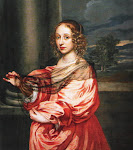
I’m so excited.
It’s nearly that time.
March/April – when my favourite flowers dress themselves and throw colour all over my spring days.
I’ve been collecting auriculas since 1995. They have moved with me from garden to garden, they still bloom faithfully and they have never once ceased to amaze me with their transcendental beauty.
What does this have to do with 17th century France?
Aha!
I could not have answered that before I bought my new favourite book...
~Yes , once again the 17th century in France starts in 1643. A major bugbear of mine but one I’ll overlook this time as the book is so glorious! ~
In the 17th century the auricular was also known as The Bear’s Ear – Auricula Ursi.
John Parkinson wrote about it in his 1629 book Paradisi in Sole.
“The Beares Ears or French Cowslips must not want their deserved commendations, seeing that their flowers, being many set together upon a stalke, does seeme every one of them to bee a Nosegay alone of it selfe; and besides the many differing colours that are to be seene in them...which increase much delight in all sorts of Gentry of the Land, they are not furnished with a pretty scent, which doth adde an encrease of pleasure in those that make them an ornament for their wearing.”
John Parkinson wrote about it in his 1629 book Paradisi in Sole.
“The Beares Ears or French Cowslips must not want their deserved commendations, seeing that their flowers, being many set together upon a stalke, does seeme every one of them to bee a Nosegay alone of it selfe; and besides the many differing colours that are to be seene in them...which increase much delight in all sorts of Gentry of the Land, they are not furnished with a pretty scent, which doth adde an encrease of pleasure in those that make them an ornament for their wearing.”
Auriculas hail from the Alps but several countries through the centuries have claimed this little flower’s perfection for themselves. In the 1700’s it was widely accepted that British gardeners were the most expert growers of auricula, despite the fact that in 1688 one N. Valney wrote in his flower gardening manual that, ‘the Bear’s Ear is French.’
Louis XIV would have agreed with M. Valney, for three years earlier he had been presented with a collection of striped varieties so new that, ‘His Majesty, who admired them, was surprised that such beautiful flowers existed in his country without him knowing about it.’
Every year I supplement my collection with a few tiny new plants. Four hundred years ago the colours most prized were red, purple, brown, buff and crimson – me, I don’t care. Any and every colour is welcome.











No comments:
Post a Comment